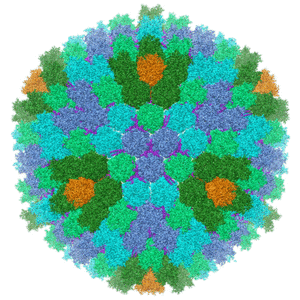

It was previously known that a cytoplasmic protein called TRIM21 (tripartite motif-containing 21) binds with high affinity to the conserved regions of antibody molecules. When adenovirions (image credit) were mixed with neutralizing antibodies and added to cells, the antibody-coated particles entered the cytoplasm where they became associated with TRIM21. This protein then links the virus particles to a small protein called ubiquitin, which labels them for degradation.
In cells that lack TRIM21 protein, adenovirus-antibody complexes are still neutralized. In this case neutralization requires complement proteins called C1q and C4. The complement system is a collection of blood and cell surface proteins that is a major primary defense and a clearance component of innate and adaptive immune responses. At least 30 different complement proteins act sequentially to produce a wide ranges of activities, from cell lysis to augmentation of the adaptive response.
When C1q protein binds antibody, it activates proteases that cleave C4 to form C4b. The latter protein is chemically reactive and binds to the nearby adenovirus capsid. Binding of C4b to the adenovirus capsid prevents the release of viral protein VI in the endosome – a protein that punctures the endosome and allows exit of the particle into the cytoplasm. In the presence of C4b, virus particles are trapped in the endosome and eventually degraded.
Cells therefore have two different mechanisms for intracellular antibody-mediated neutralization of virus infectivity. Before entering cells, virus particles may be bound by neutralizing antibodies, and in the presence of complement proteins, C4b becomes linked to the particle. When these viruses are taken into cells by endocytosis, they are trapped in the endosome. If perchance some antibody-bound virus particles escape complement binding and enter the cytosol, there they will encounter TRIM21. This interaction leads to degradation of the virus particle in the cytoplasm.
In the face of two different mechanisms for intracellular destruction of antibody-bound viruses, how can viruses still cause serious disease? The answer partly lies in the observation that many viruses encode proteins that antagonize the function of complement proteins. In other cases, antigenic variation allows evasion of virus binding by antibodies.
These observations may have applications for viral gene therapy. The prevalence of antibodies to adenoviruses in humans leads to neutralization of adenovirus vectors and limits their effectiveness. Coating of adenovirus particles with antibody fragments that cannot bind C1q or TRIM21 can interfere with neutralization of infectivity. Clinical trials should be done to determine if coating adenovirus vectors with antibody fragments improves the therapeutic benefit of gene therapy.
For a more detailed discussion of these findings, listen to TWiV 544.

Pingback: Complementing neutralization of viruses by antibodies - Virology Hub